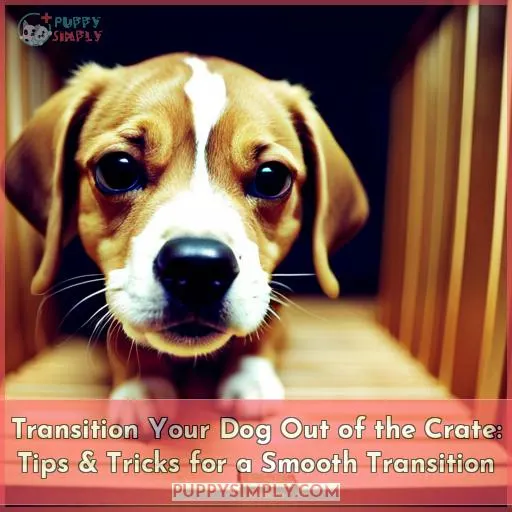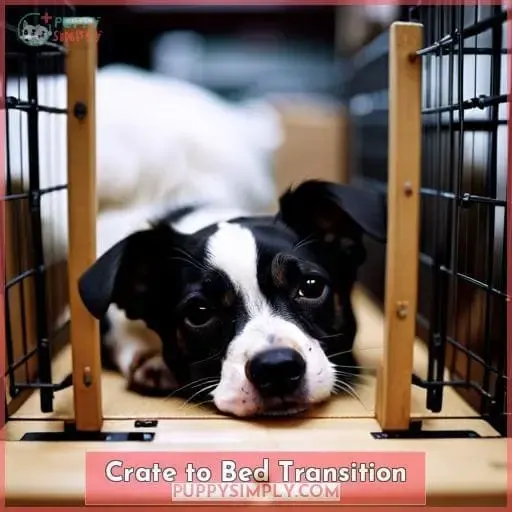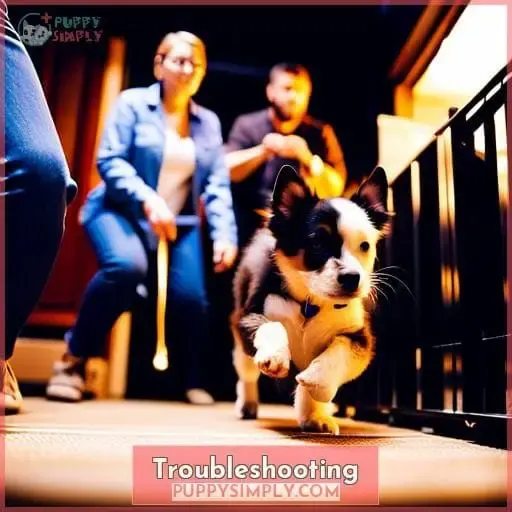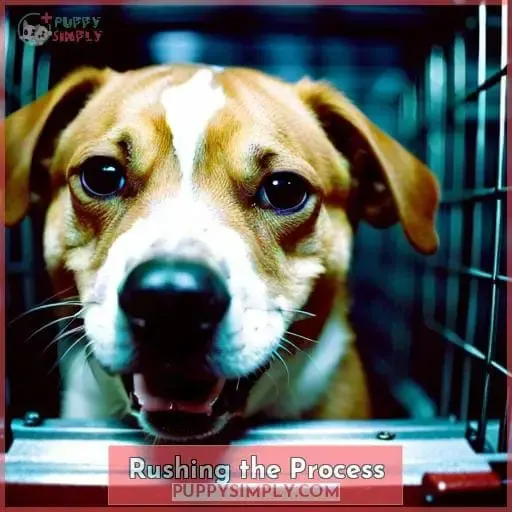This site is supported by our readers. We may earn a commission, at no cost to you, if you purchase through links.
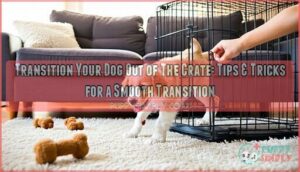 As you prepare to set your pup free from the confines of a crate, it’s like opening up a can of worms. Suddenly, there are so many questions: When is the right time? How do you transition them out safely? Fortunately, with some tips and tricks under your belt, navigating this transition process will be smooth sailing.
As you prepare to set your pup free from the confines of a crate, it’s like opening up a can of worms. Suddenly, there are so many questions: When is the right time? How do you transition them out safely? Fortunately, with some tips and tricks under your belt, navigating this transition process will be smooth sailing.
From puppy-proofing your home to providing chew toys and exercising regularly – we’ve got all the information you need for an easy move away from crating.
So buckle up as we explore how transitioning your dog out of his or her crate doesn’t have to be daunting!
Table Of Contents
Key Takeaways
- Transitioning a dog out of a crate requires patience and a gradual approach.
- Choose a high-quality dog bed for comfort during the transition.
- Introduce the bed during daytime hours first to help the dog adjust.
- Be mindful of the dog’s lifestyle needs and make the transition accordingly.
Transitioning Out of the Crate
When transitioning your pup out of confinement, remember to take it slow and start with one familiar area. Puppy-proof the room by removing any chewable objects, wires, or cleaners that may be accessible.
Provide plenty of safe toys for their entertainment and exercise needs to prevent boredom. Exercise your pup before leaving them alone for an extended period to encourage sleep and deter potential accidents throughout the day.
Once potty training and behavior become more stable, transitioning from the crate to bed at night should happen gradually over a week’s timeframe.
Positive reinforcement is also essential when teaching calming commands such as settle down, which will prevent jumping on furniture, especially when left unattended. Aim not just for obedience but also focus on anxiety management techniques, such as deep breathing exercises, which promote relaxation within the home environment overall! Avoid punishing destructive chewing habits due to boredom or stress-related issues.
Above all else, remember patience is a virtue here – don’t rush the process unnecessarily. Otherwise, it leads to frustration for both parties involved (you and the pup), and the results in the long term could have negative aftermath if done the wrong way around.
So enjoy the journey together rather than burden yourself trying to achieve an overnight success story here because it won’t work, unfortunately. Sometimes a separate bedroom option is better off temporarily until things settle down again.
Puppy-Proof Your Home
Protect your home from furry havoc by puppy-proofing it before letting Fido roam freely! It’s essential to provide a safe space where they can rely on and learn house rules.
To do this, you must establish good habits such as crate training or socializing them with other animals. Mental stimulation should also be provided through toys that promote playtime activities for their enjoyment.
Positive reinforcement is key during the transition process; reward desirable behaviors while avoiding punishing those that are unwanted so they don’t get confused between the two concepts later down the line.
Potential dangers may include chewable objects, wires, and cleaners, which should all be removed prior to allowing access into certain areas of your home for pup’s safety measures! If accidents occur in any area treated with an enzyme cleaner like Urine-Off or Wee Away, these substances help reduce odors caused by pet messes quickly without damaging surfaces due to their natural ingredients composition!
Toilet training puppies requires patience and consistency; keep an eye out for signs signaling when he needs outside relief throughout his growth stages until eventually fully potty trained indoors too – remember not all breeds have similar timelines here though, so take note accordingly depending on age & breed type specifically!
Finally, create a special corner dedicated solely towards dog beds if possible since pups love having their own personal spot away from human furniture as well – make sure you choose one according to size & sleeping preferences accurately; otherwise, it won’t work correctly over time either way unfortunately.
Good luck & happy puppy proofing everyone!!
Provide Chew Toys
Provide plenty of chew toys to keep your pup entertained and prevent destructive behavior while transitioning out. Chew toys are a great way for your pup to practice good chewing habits and address safety concerns.
Dog owners should invest in high-quality, durable chew toys that can last longer without any hazards or sharp edges. It is important to research the best toy for your pup based on their breed size, age, and activity level.
Make sure to choose toys that are easy to clean, preferably made of washable materials like rubber or plastic, as fabric toys can accumulate dirt over time if not regularly cared for.
If potty training is not yet complete, consider getting tough orthopedic dog beds that are more resistant to urine accidents. These beds will be helpful until your pup has mastered toileting indoors during nighttime hours.
Don’t forget to continue routine walks outdoors throughout the day. It is also important to provide an adequate amount of space around the bedding area, ensuring there are no objects nearby that could obstruct your pup’s sleeping position or comfort levels after long days of play.
With proper selection and placement, the transition process for your dog into a new environment can be successfully completed in no time. They might even find themselves enjoying their bedroom again soon enough, thanks to the help provided by caring pet parents who always make perfect decisions to ensure their furry friends have everything they need to live comfortably.
Their lives will be filled with joy, laughter, and love, and we hope the future holds even better things for them.
Exercise Your Dog
Exercise your pup regularly to encourage good sleeping habits and prevent any destructive behavior during the transition period. Mental stimulation, physical activity, and a daily routine are all key components of successful crate training for your pup.
Taking time each day to provide stress relief through exercise can help reduce separation anxiety when transitioning out of the crate. Make sure you’re doing it at the right time: after meals but before bedtime is ideal for most dogs being transitioned from crates.
Physical exercise helps tire out your dog so they’ll be ready for a nap when bedtime comes around – which should happen soon after their last meal in order to establish regular sleep patterns early on in life! Going on walks or playing fetch with them will give them much-needed mental stimulation as well as physical movement that has proven effective in controlling boredom-related behaviors like chewing furniture or eating dangerous objects left lying around.
You may also want to introduce some agility courses into their routine; teaching tricks such as rolling over, sit/stay commands, etc.
Crate to Bed Transition
Once your pup is fully housebroken and their behavior is stable, it’s time to take the next step – transitioning them from a crate to a bed.
Here are some tips to help you along the way:
- Choose a comfy dog bed that fits your pup’s size and sleeping preferences for maximum comfort.
- Introduce the new bed during daytime hours for about a week before transitioning at night – this will give them time to get used to it without feeling overwhelmed by darkness or changes in routine all at once!
- Make sure they’re getting enough sleep; if needed, limit access to other rooms until they’ve mastered potty training so accidents don’t happen overnight.
- Exercise can also help tire out pups who might otherwise have destructive inclinations due to boredom or separation anxiety.
- Lastly, providing plenty of chew toys can make good choices more attractive than furniture when left alone during daytime hours too!
Transitioning your pup from crate-life into free-range living doesn’t need to be stressful for either party involved. Think carefully about what works best for both you and Fido’s lifestyle needs first, then go ahead with making those necessary adjustments one step at a time while keeping an eye open towards potential pitfalls along the way.
Troubleshooting
You may experience some issues when transitioning your pup out of the crate, such as jumping on the bed or engaging in destructive chewing. Don’t panic! These behaviors are common and can usually be managed with a few simple steps.
Jumping on the Bed
Training your pup to stay off the bed takes patience and understanding. Timeouts, crate training, positive reinforcement, and mental stimulation are all essential tools in teaching them appropriate boundaries.
Separation anxiety can also be a factor; make sure they’re getting enough nap times when you’re away from home so that they don’t associate being alone with bad experiences.
Additionally, consider providing an inviting alternative such as their own small beds or treats for good behavior! Taking it slow is always best – start by taking regular walks together to build trust between you two before attempting more complex tasks like bed-training.
With time and consistency on both ends of this equation – yours as well as theirs – following these steps will help ensure a smooth transition into peaceful sleeping habits without having to worry about accidental jumps or disturbances at night anymore!
Destructive Chewing
When left unsupervised, destructive chewing can be a sign of boredom or anxiety – both of which shouldn’t be ignored. To prevent this behavior, make sure your dog is getting enough physical activity and mental stimulation every day.
Also, provide rewards for good habits to reinforce them in the long run. Older dogs may need more space than younger ones, so consider investing in larger wire cages if necessary.
If taste seems to be an issue with your skirting boards, then provide alternatives such as bitter apple spray or try using a hot sauce deterrent instead – it’s safe but effective! Finally, while you can’t completely eliminate the dog’s destructive inclinations, you can help them learn better behavior by rewarding positive actions and avoiding punishing any bad ones too harshly.
Bonding With Your Dog
Making the transition from crate to bed can be made smoother with some extra effort. Bonding with your dog is a crucial part of this process and should not be overlooked. Take time to play together, go on scheduled walks, and practice positive reinforcement during training.
This will help you build a strong relationship that sets up both parties for success.
Additionally, socialization practices are important for puppy development. Take them out in public or introduce them to new friends to help them understand how they need to behave outside their home environment.
To ensure your pup is comfortable in their new comfy bed when transitioning out of the crate at night, it’s essential that they have had plenty of exercise throughout the day. This will prevent them from becoming bored or frustrated by being confined indoors for too long, potentially leading to behavioral issues.
Rushing the Process
Rushing the transition period can be tempting, but it’s important to take things slow and steady like a tortoise rather than a hare; otherwise, destructive behaviors could result.
Separation anxiety, mental exercise deprivation, physical exercise deficiency, or stress relief are all possible consequences of rushing into total freedom from confinement in the crate too soon.
Giving your pup time to adjust is essential for success when transitioning out of their crate and into their new place with more freedoms.
Here’s 5 tips for making sure you don’t rush this process:
- Start small—introduce them slowly to just one room at first while they get used to being outside their cage during daytime hours before expanding access further throughout the house.
- Offer plenty of chew toys that provide stimulation so they won’t feel bored or frustrated.
- Provide regular opportunities for both mental and physical exercises so as not to leave them feeling restless.
- For nighttime transitions from crate-to-bed, make an effort towards bonding by regularly spending quality moments together through stories, etc.
- When troubleshooting behaviors such as chewing, try rewarding positive behavior within 3 seconds instead of punishing bad actions – remember puppies need patience!
Overall, transitioning your pup out of his/her crate should be treated with care and respect, like telling couple stories over dinner – taking enough time to appreciate each moment fully while still keeping progress moving forward steadily without ever going too fast.
Frequently Asked Questions (FAQs)
What if my dog is scared of the crate?
Try using positive reinforcement to help your dog become accustomed to the crate. Speak calmly and give treats when they enter or stay in it. Create a comforting space inside by adding blankets, toys, and other familiar objects.
Point at the crate and use a soothing word like safe to create an association between safety and their new environment.
What are the best chew toys for puppies?
Chewing helps puppies relieve boredom and anxiety. Consider durable, natural toys like Nylabones or Kongs for your pup! Hard rubber chew sticks are also great options as they help clean teeth while providing entertainment.
Make sure to switch out the toys regularly so the puppy doesn’t get bored with them.
Is it possible to transition a dog out of the crate too quickly?
Sure, transitioning a dog out of the crate too quickly can be done, but it’s not recommended. With lightning speed, you may induce anxiety and confusion in your pup that could lead to destructive behavior.
Is it better to crate train my dog during the day or night?
Crate training your pup can be a daunting task, but don’t worry! It’s not an impossible feat. Consider the benefits of both day and night crating – you’ll be amazed at how much quicker they learn when given a safe space to relax! For best results, try using exciting treats or toys that will grab their attention and make them want to stay in the crate for longer than ever before.
How long should I wait before transitioning my dog out of the crate?
Wait until your dog is fully potty trained and their behavior is stable before transitioning out of the crate. Begin with a familiar room, offer plenty of chew toys, exercise them before leaving, and introduce a high-quality bed during the day.
Conclusion
Overall, transitioning your dog out of the crate is a process that requires patience and understanding. It’s important to remember to take your time and not rush the process, as this can lead to destructive behavior.
A gentle, consistent approach will help your pup understand that their new bed is a safe and comfortable place to rest.
Like a jigsaw puzzle, it’s important to be mindful that the pieces of the transition fit together in the correct order. With a little patience and the right guidance, you can help your pup make a smooth transition out of the crate and into their new bed.

